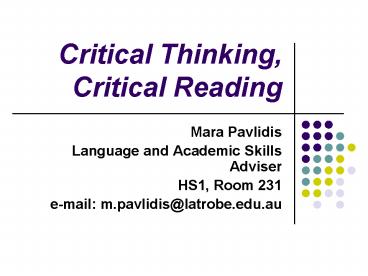Critical Thinking, Critical Reading - PowerPoint PPT Presentation
1 / 15
Title:
Critical Thinking, Critical Reading
Description:
Critical Thinking, Critical Reading. Mara Pavlidis. Language and Academic Skills Adviser ... to prepare for lectures and tutorials ... – PowerPoint PPT presentation
Number of Views:5436
Avg rating:3.0/5.0
Title: Critical Thinking, Critical Reading
1
Critical Thinking, Critical Reading
- Mara Pavlidis
- Language and Academic Skills Adviser
- HS1, Room 231
- e-mail m.pavlidis_at_latrobe.edu.au
2
Focus of session
- Reading at university
- Reading techniques
- Critical reading
- Summarising your reading
3
Reading at university - purposes
- to prepare for lectures and tutorials
- (as follow-up) to extend your understanding of a
particular topic/issue - to answer assignment questions
- to revise for tests and exams
4
Reading at university - sources
- textbooks/academic books
- (refereed) academic journal articles
- readings packages for subject (collected from
various sources) - reports by government bodies, professional
organisations
5
Reading techniques
- Skimming overview reading
- Scanning locating specific information
- In-depth reading reading for a critical
understanding
6
Skimming
- get a general understanding of the content of the
text - locate section of a chapter/article to read in
detail (for lecture, assignment) - To get the most out of skimming, you should
- - use titles and headings to help predict the
content of the text - - look at diagrams and figures before skimming
the text - - use the first sentence of each paragraph to
help you get an overview of the content
7
Scanning
- locate material relevant to a reading/essay
question - locate key words, definitions, data, etc.
- skimming and scanning are used in combination to
help you identify material you need to read in
detail
8
In-depth reading
- Enables you to, for example
- get a detailed understanding of a theory,
structure, process - critically evaluate arguments, evidence and
conclusions - identify implications for professional practice
9
Reading efficiently
- understand your purpose for reading What are you
looking for? What problem do you need to solve? - allocate time for the task according to
complexity of task, weighting of assessment - read actively highlight key points in the text,
make notes in margin, write questions, evaluate
what you are reading - adjust your reading technique to your reading
purpose - evaluate your reading strategies
10
Critical reading involves
- establishing the purpose of the text
- identifying the theories or perspectives
underpinning the authors argument - critically analysing the issues discussed
- identifying bias
- assessing the validity of arguments, evidence or
conclusions
11
Critical reading questions to ask
- Who is the author, when was this written, and
what is the context? - What is the author arguing and how does he/she
back up the claims? - Are his/her claims and conclusions valid? Why?
Why not? - How does this viewpoint compare with another?
- Which viewpoint do I accept/refute? Why?
12
Summarising your reading
- Summaries enable you to
- check your understanding
- condense a lot of information into an accessible
form - think about how aspects of the topic are linked
- create an aid for later revision
13
Types of summary
- list of points under headings (to show hierarchy
of information) paraphrased and summarised
ideas, may contain direct quotes to use in an
assignment - tables useful for summarising and comparing
features, e.g. of approaches to practice - diagrams/flow charts useful for showing how
ideas, perspectives, or topics are linked
14
Summarising from your sources
- You must understand the original text completely
to be able to summarise it. - When you write a summary, you write a shortened
version of the original text which contains the
main points. - The order of the points made in the original text
must be the same in the summary - A summary cannot change the meaning or alter the
focus of the original text. - When you summarise material for an assignment,
the summarised material should be integrated into
your own writing. It should be consistent with
the language style of the rest of the essay/case
study.
15
Paraphrasing from your sources
- You must understand the original text completely
to be able to paraphrase it. - When you paraphrase, you write the meaning of the
original text in your own words. - A paraphrase cannot change the meaning or alter
the focus of the original text. - It is generally not possible to paraphrase
technical language or discipline-specific jargon. - Paraphrased material should be integrated into
your own writing. It should be consistent with
the language style of the rest of the essay/case
study.































